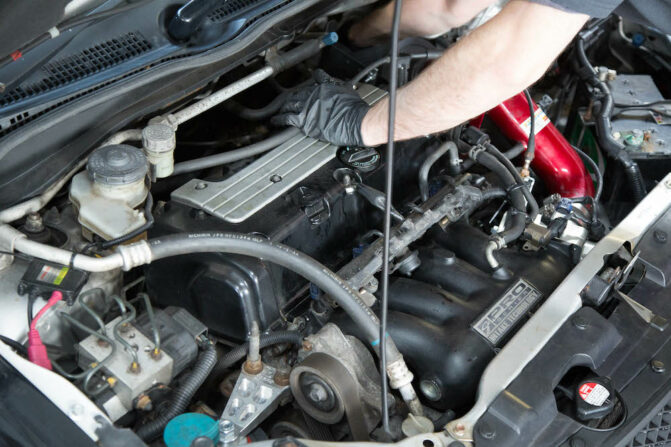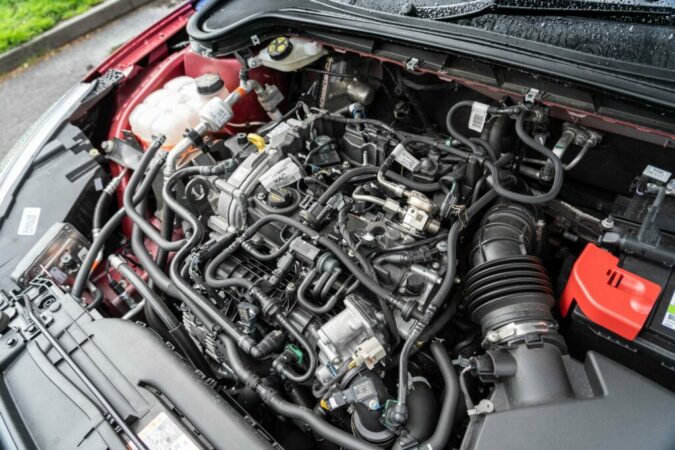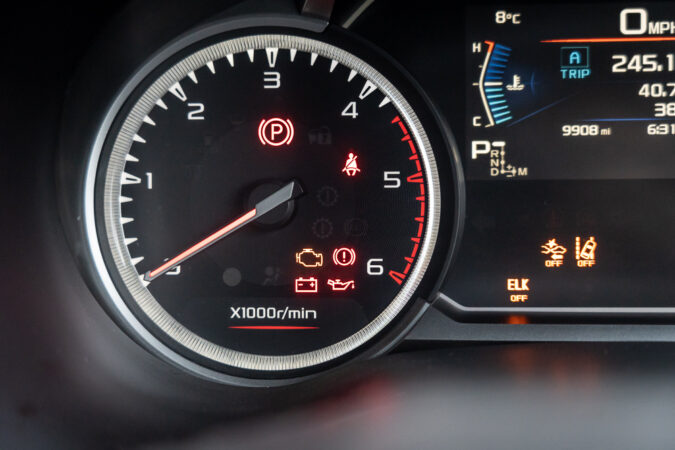Have you got a check engine light and you are experiencing some symptoms such as engine misfires and rough idle? Well, you might be experiencing some bad PCV valve symptoms. And if you suspect that, then you are at the right place because there will be a lot to cover on this topic.
Having a problem with the PCV valve on your car is a common thing. Why I’m saying this? Well, because it is true. It happened to all of us during the ownership of our cars to replace a PCV valve at some point. These components can fail and cause trouble for a lot of inexperienced drivers. But since you are here, then this means that you are on the right track.
The first thing you will need to learn when it comes to the PCV valve is how this positive crankcase ventilation system works. And understanding it can be somewhat complex because it involves some deep thinking and how everything is connected. But you shouldn’t worry because we are going to simplify everything for you.
First, we are going to cover what is the positive crankcase ventilation system and how it works. Then we will cover the PCV valve and the PCV valve function. We will learn about the PCV valve location and then we will go through the bad PCV valve symptoms and look more at the diagnostics process and the PCV valve replacement. So, if you want to learn more about how to solve your problem, please follow along.
Positive Crankcase Ventilation
Now before we dive into more complex topics and understand more about the bad PCV valve symptoms. Let’s first learn what is the PCV system in the first place and why it is so important in the internal combustion engine. This will be a great starting point for beginners to start to understand how everything is going inside of this system.
So, let’s begin, the positive crankcase ventilation system is a special system that is installed in your engine to prevent wear and tear of the internal components inside the engine. So, how does the PCV system achieves this in the first place?
Well, this is made possible with the help of gas recirculation. This system basically allows the flow of gases inside and outside of the engine.
Your engine is not something locked up and sealed tight. This engine needs to breathe. So, from one side you have a breather tube that pushes fresh air into the engine and then this air goes inside of the crankcase, and then it is pushed out by the cylinders and then it is purged by the PCV valve into the intake manifold in order to be thrown into the combustion. But why all this trouble?
Well, it is necessary because during the combustion process there is something called blowby. This is basically a fuel and air mixture that is collected by the piston rings and pushed with the oil inside of the crankcase. And this mixture needs somewhere to escape.
This is why your engine needs the positive crankcase ventilation system in order to allow the engine to dispose of these gases and burn them into the cylinders. So, whenever you notice bad PCV valve symptoms something is wrong.
What Is A PCV Valve?
And before we learn what could get wrong when you experience bad PCV valve symptoms, let’s learn more about the PCV valve and how this valve works. Knowing this will help you determine if your PCV valve has failed and is stuck in an open or closed position.
This is a simple spring-driven valve that opens and closes. It is not like a solenoid or something similar it means that it doesn’t have an electrical circuit inside of it. So, you will not need special diagnostics tools to determine if it’s bad.
This is a simple device that is mounted on the valve cover of your engine. You have probably seen that on top of both valve covers there is one hose for the breather tube and one hose for the PCV valve.
On one of the sides, there will be only a hose that is connected to the valve cover, while on the other side there will be the PCV valve. This valve design really depends from one engine to the next engine.
But most often it is a plastic device that has on one side the vacuum hose on. While on the other side is plugged into the valve cover.
This means that with a little bit of effort, you will be able to remove the PCV valve from the valve cover and replace it if you determine that it is bad. But how does the PCV valve function, what is the method of action behind this component? Let’s elaborate more on that in the following chapter.
PCV Valve Function
So, how this PCV valve works, what is the PCV valve function in general terms? Well, it is really simple to explain and in this chapter, we are going to cover that in detail before we discuss the bad PCV valve symptoms.
The first thing you need to know is that this is a spring-like device that is working with the help of a vacuum.
Meaning that all the time the PCV valve function is to suck blowby air from the crankcase. So, when the engine starts, the PCV valve opens to a point that allows the excessive air that enters from the breather tube along with the blowby gases created from the unburnt fuel vapors to escape.
Then this PCV valve drives these gases through the hose and into the throttle body. Then from the throttle body into the intake and then in the cylinders to burn.
This valve does not only relieves the pressure in the crankcase and saves the internal components of this engine. It also makes sure that this blowby doesn’t mix with the oil and create sludge. So, you will notice how there will be a lot of sludge in an engine that has a bad PCV valve.
What is also worth noting is that this PCV valve can fail and stay in an open or closed position all the time. And this will cause bad PCV valve symptoms. But more on this later on in this article, now let’s cover the PCV valve location.
PCV Valve Location
Now let’s discuss the PCV valve location. Where is this valve usually located? Well, it really depends.
Back in the day, you had one vacuum hose on one valve cover and another with the PCV valve on the other. But nowadays people are not running V8 engines, at least not most of them.
So, the PCV valve is usually mounted at one side of the engine if you are running an inline engine. The mounting PCV Valve location usually depends from manufacturer to manufacturer.
So, your best bet would be to learn what type of engine you are running. Then browse the engine name along with the phrase “PCV valve location”. You can also look for the make and model and the phrase “PCV valve location”.
There are a lot of videos on YouTube and forums that you could check in order to locate this valve and replace it if necessary. But before you decide on replacing it, you might want to learn about the bad PCV valve symptoms. And in the next chapters, we are going to cover all of these symptoms in depth so you get a better picture of what you can expect when you have a bad PCV valve on your car.
PCV Valve Symptoms
Now as we covered the basics of the PCV system and we learned how the PCV valve works in reality. Let’s now focus on other things which are more important to us.
Namely, the bad PCV valve symptoms that are associated with this valve and how to tackle them. Knowing the symptoms will help you easily tell a good PCV valve from a bad one and replace it. Without replacing a ton of expensive parts instead of this cheap component. Now let’s begin covering the symptoms.
1. Check Engine Light
The first in our list of bad PCV valve symptoms that we are going to add is the check engine light. But why is this the case? The PCV valve is not connected to the wiring harness meaning that it is not connected to the computer. Why the check engine light turns on?
Well, this will be the case because there will be a lot of “unmetered” air that will enter the engine if the PCV valve is stuck in an open position all the time.
This is not really an unmetered air since it enters after the throttle body. But there will be a ton of air that will enter and cause a ton of issues with the air to fuel mixture. Namely with the MAF and other sensors that serve the purpose of maintaining this air to fuel mixture.
Codes like P0171 or P0174 that indicate a lean air to fuel mixture will be present (such as the P0174 Chevy code or the P0171 code Toyota). A lean mixture in fact is the situation when there is too much air and too little fuel in the system.
So, beware of this PCV valve and the bad PCV valve symptoms before you jump into replacing something really expensive like a MAF sensor. You just don’t want to do that mistake.
2. Bad PCV Valve Sound
The second in our list of bad PCV valve symptoms that we are going to cover is the bad PCV valve sound. What is worth noting first is that you will not be able to tell if your PCV valve is not working if you don’t remove it.
A good PCV valve should produce sound. So, if yours does not produce a rattling noise, then it probably doesn’t work.
How you can do that is really simple. Just locate the PCV valve on your car and remove it. Then place your pointing finger on one side and the thumb on the other side. Then give it a good wiggle.
A good PCV valve should produce a rattle when you do this practice. While a bad PCV valve should be silent. You can see more in the video above about how you can pull this off. More on this we are going to explain later on when we will learn how to diagnose this problem. But now let’s stick with the bad PCV valve symptoms.
3. Rough Engine Idle
The third in our list of bad PCV valve symptoms is definitely the rough engine idle. This happens especially in case the PCV valve is stuck in an open position. So, why is this the case?
Remembered that we told you that this valve when stuck open allows too much air to get sucked into the engine? Well, that is causing this situation.
The engine air to fuel mixture will be really bad and you will get issues like this on your car. You will notice how the needle on the tachometer fluctuates and the engine simply doesn’t run smooth.
Surges in performance can also be present when you drive the car. So, when it comes to bad PCV valve symptoms, it is worth noting that this symptom is the most common one that you can get. So, be really aware of it.
4. Engine Misfires
The fourth in our list of bad PCV valve symptoms is the situation with the engine misfires. So, why is this the case and what are misfires in general?
Well, this is the case because of the poor air to fuel mixture. The engine will simply not be happy with this type of engine work and you will end up with a poor working engine.
Engine misfires in general are explosions that happen prematurely inside of the cylinder or they are delayed. This means that the combustion is not properly timed out since the air to fuel mixture is bad. So, this is one of the outcomes of this situation.
Whenever you have misfires, the first things that you want to check are the spark plugs and then move on from there. The PCV should be one of your options since it is the second most common cause of misfires and bad PCV valve symptoms. Now let’s move on to the next symptom.
5. Oil Leaks
Another on our list of bad PCV valve symptoms is the oil leaks that will come from everywhere if you drive a car with a bad PCV valve. But why will this happen?
Well, unlike the previous symptoms that we covered that happen when the PCV valve is stuck open. The oil leaks occur when the PCV valve is stuck closed.
When this valve is closed means that there is no ventilation at all inside of the crankcase. So, whenever there is no place for this pressure to escape, you can expect this pressure to find its way outside of the engine and cause a ton of damage if you do not detect it on time.
The oil pan gasket can fail and start leaking, the front and rear main seals can fail, and the head gasket can fail, you name it. Oil leaks will start coming from everywhere when you have a bad PCV valve. Now let’s move to the next Bad PCV valve symptoms.
6. Sludge In Oil
Another in our list of bad PCV valve symptoms is the situation when you get oil sludge. Imagine that your PCV valve is closed and all the fuel vapors that get collected by the piston end up inside of the block.
Then these fuel vapors will end up mixing with the engine oil and you will basically end up with a sludgy engine. This will cause a ton of friction inside of the engine and this friction will cause your engine to wear off prematurely. So, be really aware of these bad PCV valve symptoms. Now let’s move on to the last symptom on our list.
7. Smokey Exhaust
And the last in our list of bad PCV valve symptoms that we are going to cover is the situation with the smokey exhaust.
Whenever the PCV valve is stuck closed, you can expect a situation like this when the engine burns oil.
This pressure that is building up in the crankcase has to escape from somewhere and the piston rings might be a good place. Whenever the oil goes in the opposite direction, then things are going to be really messy.
The engine will burn a ton of oil and you will have an exhaust that smokes like a train that runs on coal. Not an ideal situation. This means that you need to diagnose this problem with your car based on the PCV valve symptoms. And in the following chapter, we are going to explain how you can do that.
PCV Valve Replacement
Now since we covered the bad PCV valve symptoms, we can slowly move on to diagnosing the issue. How you can diagnose a bad PCV valve? Actually, it is quite easy. Let’s explain.
The PCV valve is not connected to the PCM so you cannot diagnose this component with a scanner or a multimeter since it doesn’t contain any electrical circuits.
The thing you can do is to unplug the PCV valve and leave the hose on. Then start the car and leave it running. Then place your thumb on the valve and see if there is a vacuum created. The more the RPM you give it, the more vacuum should be created.
If there is no vacuum, it means that your PCV valve is stuck close and doesn’t work. This is the way how you diagnose a stuck closed PCV valve.
On the other hand, if you want to see if your PCV valve is stuck open, you can rely on some of the symptoms that we discussed. Mainly lean air to fuel mixture and frequent misfires, rough idle, poor engine work.
Another thing that you can try is to give this PCV valve a shake test. Just remove the valve from the car. Give it a wiggle. A good PCV valve should produce a rattle. If your valve doesn’t rattle it means that it is bad and you need a PCV valve replacement.
Replacing this valve is really one of the simplest things you can do. Just remove the old one and plug the new PCV valve in. And no more bad PCV valve symptoms.
PCV Valve Replacement Cost
We covered the bad PCV valve symptoms, now let’s focus more on the PCV valve replacement cost. How much can you expect to pay for a new PCV valve?
Well, not much. PCV valves are really affordable and you can get one for like $5 or $10. You can also replace it by yourself for free or if you go to a shop, you can pay about $120 for diagnosing and up to $200 in total with the labor and parts costs. It’s up to you which route you go.
Conclusion
In this article, we have covered quite a bit when it comes to the bad PCV valve symptoms. First, we have covered the positive crankcase ventilation system and the PCV valve. We learned what is their task and how they operate.
Then we have covered all of the bad PCV valve symptoms and how you can diagnose and replace one and at what cost. Now let’s answer some frequently asked questions.
F.A.Q
Now let’s answer some frequently asked questions.
What Does PCV Stand For
PCV stands for Positive Crankcase Ventilation System. This is a special ventilation system that allows your block to breathe and keep the engine safe from internal damage.
What Is A PCV Valve
A PCV valve is a special valve of the PCV system that opens and closes when there are too many fumes in the crankcase and allows them to escape and then be redirected to the intake manifold.
What Does A PCV Valve Do
The PCV valve is the valve that is in charge of releasing the pressure of the PCV system and basically saving your engine. One of the most important components of your car.
What Are The Symptoms Of A Bad PCV Valve
The symptoms of a bad PCV valve might include, rough engine idle, engine misfires, poor engine work, sludge in oil, check engine light, black smoke from the exhaust, oil leaks, and more.
How To Tell If PCV Valve Is Bad
You can try to remove the valve from the engine and leave the hose attached. Then turn on the engine and see if the valve is creating a vacuum. If it does, then it is probably not stuck close. Another thing that you can do is to remove it and give it a little wiggle. If it rattles it means that it is good.
How To Test PCV Valve
You can test this component by removing it from the engine and giving it a little wiggle. It if rattles, then it means that it is good. If it doesn’t rattle, the spring inside is probably broken.




